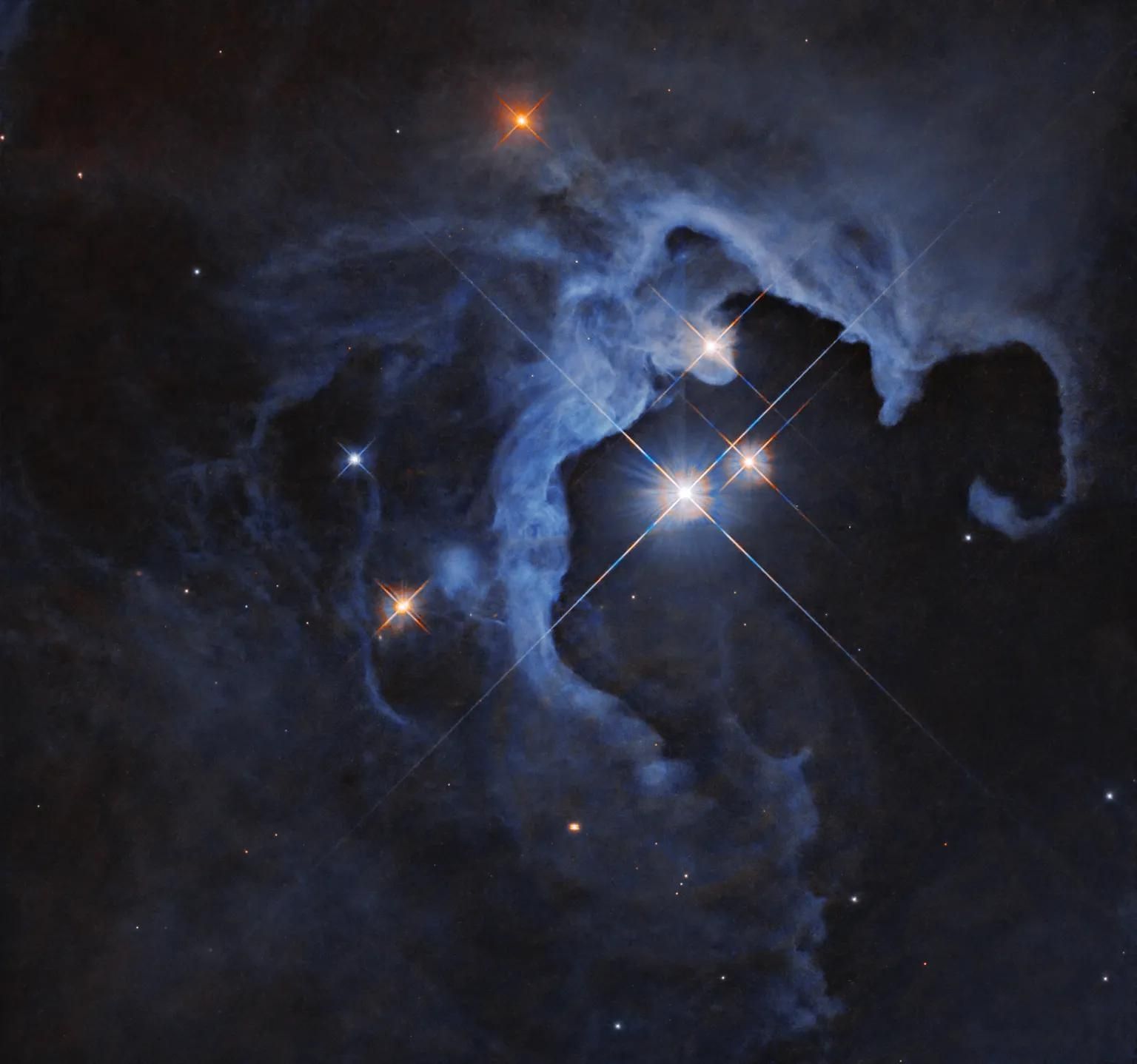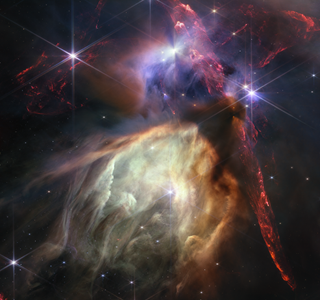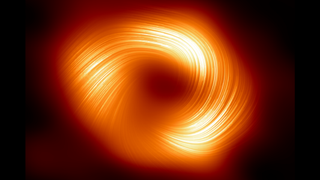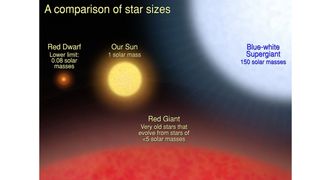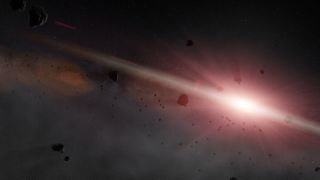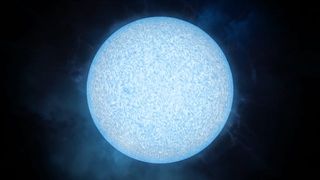This NASA Hubble Space Telescope image captures a triple-star star system. NASA, ESA, G. Duchene (Universite de Grenoble I); Image Processing: Gladys Kober (NASA/Catholic University of America) Looking like a glittering cosmic geode, a trio of dazzling stars blaze from the hollowed-out cavity of a reflection nebula in this new image from NASA’s Hubble Space Telescope. The triple-star system is made up of the variable star HP Tau, HP Tau G2, and HP Tau G3. HP Tau is known as a T Tauri star, a type of young variable star that…
Read MoreTag: Stars
Achoo! Baby star ‘sneezes’ tell astronomers a lot about their development
Every new parent knows the cold anxiety that grips them when their baby sneezes for the first time. That’s when a litany of possible issues and ailments probably begin to irrationally race through your mind. Researchers now know baby stars also “sneeze,” but these infinitely more powerful post-natal sneezes launch gas, dust, and magnetic energy. In other words, they’re more useful to the cosmos than stressful. These eruptions from so-called “protostars” are actually a vital part of stellar development, and can tell scientists a great deal about that stellar body’s evolution…
Read MoreCannibal stars at the heart of the Milky Way stay young in a gruesome way
Scientists have discovered the gruesome secret behind the apparent youth of some of stars at the heart of the Milky Way — stars participating in a sort of cosmic demolition derby around our galaxy’s supermassive black hole, Sagittarius A*, or Sgr A*. Like a cosmic version of 17th-century serial killer Elizabeth Bathory, who supposedly sought to maintain her youthful glow by bathing in the blood of her victims, some of these stars seem to stay looking young by slamming into their neighbor stars and coating themselves in the stolen stellar…
Read MoreHubble Space Telescope finds bucket of cosmic Easter eggs — 500 blue and red stars
In December 2023, the Hubble Space Telescope completed its largest program since launching in 1990. With this program, the telescope made observations of 500 individual stars over three years — and scientists are now ready to dive into this cosmic Easter egg of data. The comprehensive Hubble Telescope survey is called the Ultraviolet Legacy Library of Young Stars as Essential Standards, or ULLYSES; Hubble was deemed by ULLYSES operators as the sole active telescope capable of accomplishing such a pioneering endeavor. These ultraviolet-light-observation treats will last way past the Easter holiday,…
Read MoreStardust particle locked in meteorite holds secrets of a star’s explosive death
Scientists have discovered a rare stardust particle that came from the explosive supernova death of a distant star. This speck, it seems, is locked within an ancient meteorite. The grain of dust, though small, can help tell a story of stellar life, death and rebirth that spans almost the entire 13.8 billion-year history of the cosmos. It could also allow scientists to unlock the secrets of a recently discovered type of star that dies in a unique supernova explosion. “These particles are like celestial time capsules, providing a snapshot into…
Read MoreHow are extreme “blue supergiant” stars born? Astronomers may finally know
Astronomers may have solved the mystery of how some of the brightest and hottest stars in the cosmos are born. The team, led by researchers at the Instituto de Astrofísica de Canarias (IAC), found clues that suggest blue supergiants are created when two stars in a binary system spiral together and merge. B-type blue supergiant stars are at least 10,000 times brighter, two to five times hotter and 16 to 40 times more massive than the sun. Blue supergiants are so extreme that scientists have theorized that they may have…
Read MoreDark Energy Camera captures record-breaking image of a dead star’s scattered remains
This billowing mass of dust filaments and gas tendrils stretching across 100 light-years of space like delicate lace is the Vela supernova remnant — scattered ashes of a star that exploded about 11,000 years ago. The image was acquired by the Dark Energy Camera (DECam), which is mounted on the Victor M. Blanco 4-Meter Telescope at the Cerro Tololo Inter-American Observatory in Chile. DECam was originally designed to conduct a survey of distant galaxies to measure the strength of dark energy as it accelerates the universe’s expansion and draws those…
Read MoreJames Webb Space Telescope spots neutron star hiding in supernova wreckage
Using the James Webb Space Telescope (JWST), astronomers have ended a nearly decade-long game of celestial hide-and-seek after they discovered a neutron star in the wreckage of a stellar explosion. Supernova 1987A represents the remains of an exploded star that once had a mass around 8 to 10 times that of the sun. It is located around 170,000 light-years away in the Large Magellanic Cloud, a dwarf galaxy neighbor of the Milky Way. Supernova 1987A was first spotted by astronomers 37 years ago in 1987, hence the numerical aspect of…
Read MoreRadio signals from Orion nebula reveal new data about strange celestial objects: ‘JuMBOS’
Last year, using the James Webb Space Telescope (JWST), astronomers made the startling discovery of some free-floating, planetary-mass objects in the Orion nebula that threw their ideas of planet and star formation into doubt. And now, new research has further deepened the mystery around these so-called Jupiter-mass binary objects, or JuMBOs. JuMBOs aren’t stars, but aren’t really planets either. Mark McCaughrean, senior science advisor at the European Space Agency (ESA), and colleagues originally located the objects in the Orion nebula. This nebula is a star birthing region, also known as Messier…
Read MoreScientists create 5 new isotopes to learn how neutron star collisions forge gold
Researchers have synthesized five new isotopes that could help bring the stars down to Earth — and coax scientists a step closer to understanding how collisions between ultra-dense, dead stars could create heavy elements like gold and silver. The isotopes are Thulium-182, thulium-183, ytterbium-186, ytterbium-187 and lutetium-190; this is the first time they’ve been ever been synthesized on Earth. Their creation took place at the Facility for Rare Isotope Beams (FRIB) at Michigan State University (MSU) and represents a step towards building atoms on Earth that are typically only created…
Read More